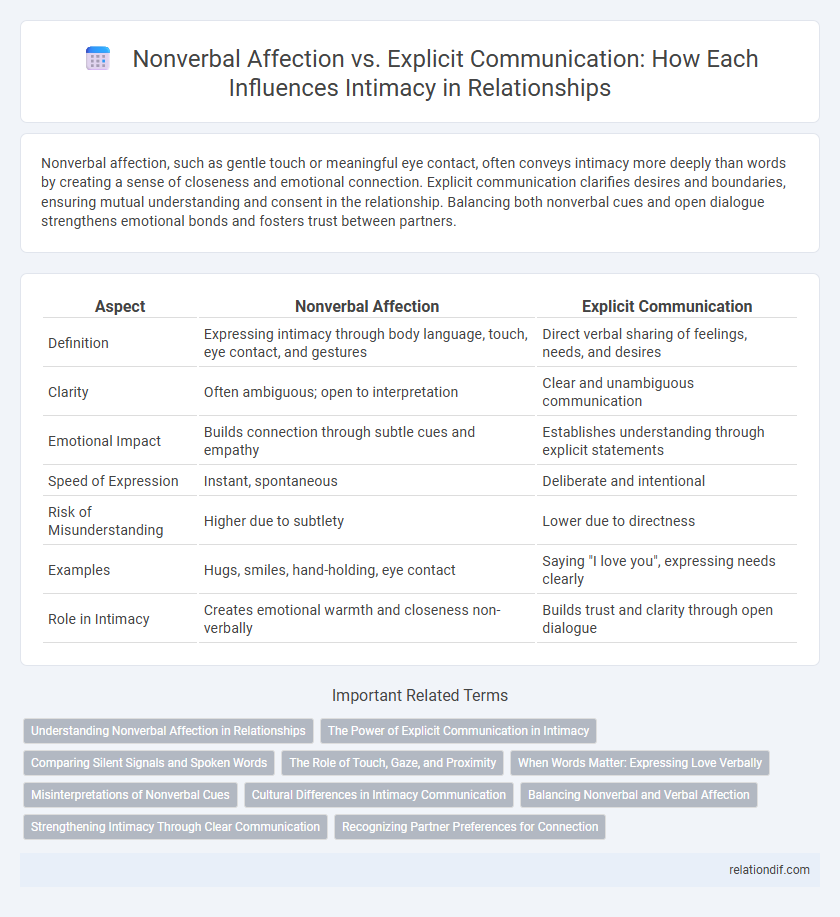Nonverbal affection, such as gentle touch or meaningful eye contact, often conveys intimacy more deeply than words by creating a sense of closeness and emotional connection. Explicit communication clarifies desires and boundaries, ensuring mutual understanding and consent in the relationship. Balancing both nonverbal cues and open dialogue strengthens emotional bonds and fosters trust between partners.
Table of Comparison
| Aspect | Nonverbal Affection | Explicit Communication |
|---|---|---|
| Definition | Expressing intimacy through body language, touch, eye contact, and gestures | Direct verbal sharing of feelings, needs, and desires |
| Clarity | Often ambiguous; open to interpretation | Clear and unambiguous communication |
| Emotional Impact | Builds connection through subtle cues and empathy | Establishes understanding through explicit statements |
| Speed of Expression | Instant, spontaneous | Deliberate and intentional |
| Risk of Misunderstanding | Higher due to subtlety | Lower due to directness |
| Examples | Hugs, smiles, hand-holding, eye contact | Saying "I love you", expressing needs clearly |
| Role in Intimacy | Creates emotional warmth and closeness non-verbally | Builds trust and clarity through open dialogue |
Understanding Nonverbal Affection in Relationships
Nonverbal affection plays a crucial role in relationships by conveying emotions through gestures like touch, eye contact, and body language without spoken words. These silent signals strengthen emotional bonds and foster trust, often expressing feelings more effectively than explicit communication. Recognizing and interpreting nonverbal cues enhances intimacy by creating a deeper, more intuitive connection between partners.
The Power of Explicit Communication in Intimacy
Explicit communication in intimacy enhances emotional clarity by directly expressing desires, boundaries, and feelings, reducing misunderstandings common in nonverbal affection. Verbalizing needs fosters deeper trust and connection, as partners gain precise insight into each other's expectations and vulnerabilities. Research highlights that couples practicing clear, open dialogue report higher satisfaction and stronger relational bonds than those relying primarily on nonverbal cues.
Comparing Silent Signals and Spoken Words
Nonverbal affection involves silent signals such as touch, eye contact, and body language that convey intimacy without spoken words, often fostering deeper emotional connection through subtle cues. Explicit communication relies on clear, spoken expressions of feelings and desires, providing clarity and reducing misunderstandings in intimate relationships. Both modes play crucial roles, with silent signals enhancing emotional resonance and spoken words ensuring mutual understanding and consent.
The Role of Touch, Gaze, and Proximity
Touch plays a crucial role in nonverbal affection, conveying warmth, comfort, and emotional connection that words often cannot express. Gaze establishes intimacy through mutual eye contact, signaling attention, trust, and vulnerability between partners. Proximity, or physical closeness, enhances the sense of security and bonding, reinforcing emotional ties without the need for explicit communication.
When Words Matter: Expressing Love Verbally
Verbal expressions of love provide clarity and reassurance that nonverbal affection alone may lack, enhancing emotional intimacy through precise communication. Studies show that couples who frequently articulate their feelings tend to experience higher relationship satisfaction and reduced misunderstandings. Explicit communication bridges emotional gaps, fostering trust and deepening connection beyond physical gestures.
Misinterpretations of Nonverbal Cues
Nonverbal affection often conveys emotions through gestures, facial expressions, and touch, but these cues can be easily misinterpreted due to cultural differences or individual sensitivities. Misreading a smile, a lack of eye contact, or ambiguous body language may lead to misunderstandings in intimacy, affecting emotional connection and trust. Clear, explicit communication helps clarify intentions and prevents the confusion that arises from relying solely on nonverbal signals.
Cultural Differences in Intimacy Communication
Nonverbal affection varies widely across cultures, with gestures like hugging, eye contact, and personal space holding different meanings that influence intimacy expression. Explicit communication about feelings is often preferred in Western cultures, where verbal affirmation strengthens emotional bonds, while many Eastern cultures rely more on implicit cues and shared experiences to convey intimacy. Understanding these cultural nuances is essential for interpreting and fostering intimacy in cross-cultural relationships.
Balancing Nonverbal and Verbal Affection
Balancing nonverbal affection and explicit communication enhances intimacy by integrating physical cues like touch, eye contact, and body language with clear verbal expressions of love and appreciation. Nonverbal signals convey deep emotional connections that words may not fully capture, while verbal communication clarifies intentions and reinforces feelings. Combining both methods fosters mutual understanding and strengthens the emotional bond in relationships.
Strengthening Intimacy Through Clear Communication
Nonverbal affection, such as touch, eye contact, and body language, conveys deep emotional connection and trust, often strengthening intimacy on an instinctual level. Explicit communication complements these signals by articulating feelings, needs, and boundaries clearly, reducing misunderstandings and fostering emotional safety. Together, combining clear verbal expressions with consistent nonverbal cues builds a robust foundation for enduring intimacy in relationships.
Recognizing Partner Preferences for Connection
Recognizing partner preferences for connection involves understanding the balance between nonverbal affection and explicit communication, as some individuals respond more deeply to touch, eye contact, and gestures while others prefer clear verbal expressions of love and support. Prioritizing these preferences enhances emotional intimacy by aligning actions with the partner's unique love language, fostering a secure and connected relationship. Tailoring intimate interactions based on these cues strengthens mutual trust and satisfaction.
Nonverbal affection vs explicit communication Infographic

 relationdif.com
relationdif.com